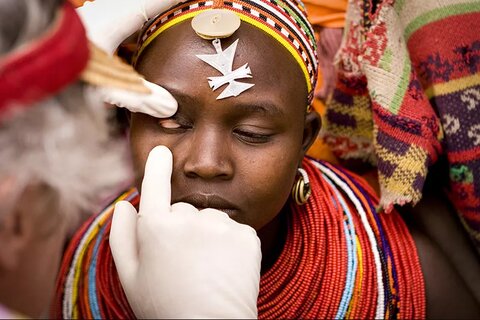Trachoma

Trachoma is the world’s leading infectious cause of blindness. It is caused by infection from the bacterium chlamydia trachomatis which spreads through contact with eye discharge from an infected person – via hands, towels, sheets and, in some cases, eye-seeking flies, and thrives where there is poor sanitation and limited access to water for personal hygiene.
Repeated infection damages the eyelids in some individuals so that the normal defences are compromised causing the eyelashes turn inwards and rub painfully against the eyeball surface. This advanced stage of the disease, trachomatous trichiasis, is extremely painful and has a profoundly negative impact on an individual’s quality of life. Trichiasis can be corrected by eyelid surgery, however, if left untreated, it may lead to irreversible low vision and blindness.
Burden
Approximately 200 million people worldwide living in trachoma-endemic districts and 3.2 million people need surgery to avoid blindness because of trachoma.
Trachoma can destroy the economic well-being of entire communities, keeping affected families trapped in a cycle of poverty as the disease passes from one generation to the next. The disease is responsible for an estimated annual productivity loss of up to US$8 billion while eliminating trachoma will cost around US$1 billion dollars, of which US$200-300 million is already committed.
Children are the most susceptible to infection but the blinding effects of repeated infection do not usually develop until adulthood. Women are up to four times as likely as men to develop trichiasis, in part because of repeated exposure to their children's infections. The disabling effects of vision loss further compounds other common challenges faced by poor and marginalised people.
WHO Alliance for the Global Elimination of Trachoma by 2020
In 1998, the WHO Alliance for the Global Elimination of Trachoma by 2020 (GET2020 Alliance) was created to address this health and development burden. The GET2020 Alliance is the principal platform through which the trachoma prevention community works together towards a shared goal. It includes representatives from 51 endemic country governments as well as other non-government development organizations (NDGOs), academic institutions, and donor and private sector stakeholders. In 2016, the GET2020 Alliance released Eliminating Trachoma: Accelerating Towards 2020, which outlines what needs to be done to scale up programs and strengthen health systems to achieve the global elimination of trachoma by the year 2020.
The SAFE strategy
Adding further support to the Alliance, in May 1998, the 51st World Health Assembly adopted a resolution calling for the elimination of trachoma as a cause of blindness and recommending that Ministries of Health pursue the trachoma treatment and prevention strategy known as SAFE to do so (WHA Resolution 51.11).
The SAFE strategy consists of: Surgery, to halt the damage caused by inverted eyelashes; Antibiotics, to treat infection and prevent transmission; Face washing, to improve hygiene and reduce the spread of infection; and Environmental change, to improve sanitation and access to clean water.
The delivery of this comprehensive approach is critical for the sustainability of trachoma elimination, which may be particularly contingent on the facial cleanliness and environmental improvement components. Importantly, trachoma interventions are undertaken within national health systems and integrated into national priorities, contributing to health system strengthening through the building of knowledge, skills and capacity.
Find out more about current efforts to eliminate trachoma, read:
Eliminating Trachoma: Accelerating Towards 2020
Trachoma facts and statistics
Photo credit: CBM